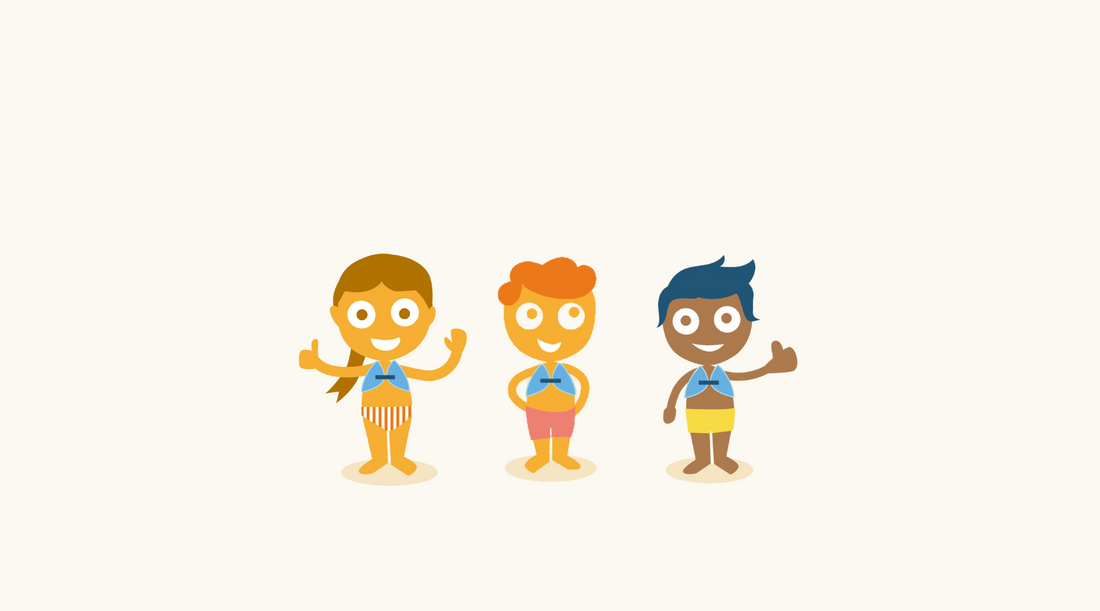Do I want to teach my child to save themselves from the age of 2 after an unexpected fall into the water? Or do I restrict them for the next four years in their development or freedom of movement with arm floaties or life jackets? By popular request, this blog discusses the difference between traditional arm floaties or life jackets and Fibby. And why parents, experts, and Olympic swimmers applaud the transition from arm floaties and life jackets to playful learning with Fibby.

Arm Floaties or Life Jackets? Children aged 2 can do more!
Learning to swim is a milestone eagerly anticipated by both children and parents. Although children from the age of two cannot perform the breaststroke, they have a remarkable ability to propel themselves in water. Whereas arm floaties and life jackets used to hinder the development of these essential water skills, today there are more advanced techniques and swimming aids, like Fibby, that help children become more self-reliant in the water.

Are Arm Floaties or Life Jackets the Safest?
Until recently, the prevailing belief was that it is safest to provide children aged 2 and up with as much buoyancy as possible in the form of arm floaties and life jackets. This taught children that they need to do little to stay afloat while swimming. Although this may seem convenient, it sets them up for trouble if they ever unexpectedly fall into the water without these aids. The support they relied on and naturally seek is suddenly gone.
The new generation of swimming aids takes parents and children out of their passive role and challenges them to develop essential water skills together.
The new generation of swimming aids takes parents and children out of their passive role and challenges them to develop essential water skills together. Not to replace parental supervision or swimming aids, but to give children skills, confidence, and awareness of their own abilities for unexpected situations.

New Philosophy: Encourage Self-Reliance from Age 2
Fibby's tilting mechanism ensures that children don't just passively float in the water; it positions children fully mobile and slightly upright in the water. This helps them develop essential skills such as maintaining balance, treading water, and independently lifting their faces. Fibby's natural positioning in the water differs minimally from the posture without Fibby. This facilitates a smooth transition to moving through water without Fibby's support. In short; every time you swim with Fibby, you also practice dealing with unexpected situations in and around the water.

Playful Learning with the Fibby Learning App
But how do you encourage what children may initially find daunting but what they can naturally do? Through the universal language of play! With the help of videos, instructions, and games, the Fibby app guides parents and children step by step on their water adventure towards self-reliance.
As soon as children are given the freedom and opportunity to discover and experiment in the water during play, the development of motor skills such as arm movements, balance, and coordination 'naturally' occurs.
As soon as children are given the freedom and opportunity to discover and experiment in the water during play, the development of motor skills such as arm movements, balance, and coordination 'naturally' occurs. While having fun, children explore different ways of moving through the water and are naturally drawn to movements that feel most comfortable for them.
Watch a video from the Fibby learning app and discover the magic of learning to swim with Fibby: step-by-step guidance and enjoyable water adventures where learning happens 'naturally'.
Risky Play & Water Safety
Fibby and the learn through play method, developed with Dutch Don’t Drown Foundation and Hogeschool Windesheim, are part of a growing trend in parenting called 'Risky Play', which boils down to 'as safe as necessary, as risky as desired'. Parents, researchers, and experts alike show great enthusiasm for this new approach to child development.
Parents, researchers, and experts alike show great enthusiasm for this new approach to child development.
By tackling challenges and overcoming obstacles together, children learn to manage risks and make decisions. Even in unexpected situations. Risky play also offers special opportunities for growth and learning that structured lessons do not provide. As a result, children are more likely to remember what they have learned and apply it independently.
 Together with Dutch Don’t Drown Foundation and Hogeschool Windesheim, we are committed worldwide to reduce drowning, the third leading cause of death among children under twelve. Through projects, children learn through play to become self-reliant after falling into the water
Together with Dutch Don’t Drown Foundation and Hogeschool Windesheim, we are committed worldwide to reduce drowning, the third leading cause of death among children under twelve. Through projects, children learn through play to become self-reliant after falling into the water
The Advantages of Fibby Compared to Arm Floaties and Life Jackets
- Learning to float and move in a natural swimming position together playfully
- Discovering and growing together: be amazed by every progress and celebrate together!
- Becoming self-reliant from the age of two
- Awareness of one's own water skills for parent and child
- Fibby app: easy-to-follow videos and games for parents and children
- Continuing to swim? Then ahead of swimming lessons.
- The first and only certified according to the latest and strictest standard EN 13181-1 2021
- Comfortable fit and materials
- A new playmate
Disadvantages of Arm Floaties
- Struggle with your child to keep wearing the arm floaties while playing by the water's edge
- Quickly break
- Unnatural swimming position
- Hinders development towards self-reliance
- child cannot assess their own skill level

Parental Supervision
Chances are, you grew up with arm floaties yourself. It was the way for parents to give children a sense of safety in the water. However, the world does not stand still, and now is the time for parents to discover water, self-confidence, and self-reliance together with their children through play.Fibby, like arm floaties and life jackets, is certified as a swimming aid. Designed to teach children swimming strokes.
With Fibby, parents return to that essence. Learning and growing together in the water with your child, years before they are ready for swimming lessons
With Fibby, parents return to that essence. Learning and growing together in the water with your child, years before they are ready for swimming lessons. Is your child free and confident in the water, even without Fibby? Then you never discharge this, just like with other swimming aids, from your parental supervision duty. Children should also continue to wear Fibby by the water until they have a swimming proficiency diploma. Fibby’s design - children often call it their buddy - and full freedom of movement help with this.
Listen to the inspiring words of world champion and Dutch Olympic swimmer Kira Toussaint as she explains why she became an ambassador for Fibby. She wishes every parent and child the same fantastic experiences she has had

